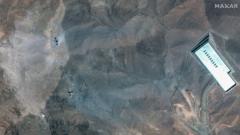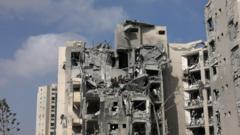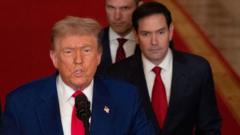In a volatile 24-hour period, escalating tensions in the Middle East prompted the US to step in, mediating a ceasefire between Iran and Israel after military attacks escalated. Trump's last-minute interventions aimed to stabilize the situation, but continued threats from both sides raised concerns regarding the future of peace.
Tensions Ease: A 24-Hour Journey to Middle East Ceasefire

Tensions Ease: A 24-Hour Journey to Middle East Ceasefire
Rapid developments unfold as the US mediates between Iran and Israel, leading to a fragile ceasefire amidst escalating military conflict.
Article:
Since mid-June, tensions have reached a boiling point in the Middle East, marked by Israel's destructive military campaigns targeting Iranian sites and Iranian missile responses breaching Israeli defenses. However, within just 24 hours, the complex dynamics took a dramatic turn. The day began with a heightened sense of urgency as Iran's Supreme Leader issued orders to retaliate against the US military presence in Qatar amidst escalating hostilities.
At the al-Udeid airbase in Qatar, US citizens were advised to stay sheltered as a precautionary measure due to credible threats of Iranian missile attacks. The airspace over Qatar was secured, with the local government and US officials bracing for possible conflict. As explosive moments unfolded, Iran's state media confirmed its attacks, but the swift interception of missiles ensured no casualties occurred—indicating a calculated response designed to express strength without igniting further conflict.
As reports of a potential ceasefire began to circulate, President Trump also made headlines with his unexpected shift toward diplomacy. In a series of posts on social media, he acknowledged Iran’s missile attack, yet advised forgo escalation, hinting that it might be time for peace in the region. Behind the scenes, frantic negotiations involving US, Iranian, and Israeli officials emerged as communication channels were opened, leading to increasing momentum for a ceasefire agreement.
However, as late as evening approached, the situation escalated once more, with sirens wailing across Israel as Iranian missiles were launched, resulting in civilian casualties. Israel responded to these provocations with military action, but Trump urgently intervened, demanding all parties adhere to the new ceasefire agreements—a troubling signal that despite the announcement, conflict had not truly subsided.
As the dawn broke over Washington DC, Trump faced the media, emphasizing the need for restraint. His communications with Netanyahu hinted at tension, revealing an awareness that deeper aggressions could unravel the fragile peace he had worked to establish. Throughout this whirlwind of events, it appeared that while a formal ceasefire was in effect, the situation remained precarious, and the path ahead remained fraught with uncertainty.
Since mid-June, tensions have reached a boiling point in the Middle East, marked by Israel's destructive military campaigns targeting Iranian sites and Iranian missile responses breaching Israeli defenses. However, within just 24 hours, the complex dynamics took a dramatic turn. The day began with a heightened sense of urgency as Iran's Supreme Leader issued orders to retaliate against the US military presence in Qatar amidst escalating hostilities.
At the al-Udeid airbase in Qatar, US citizens were advised to stay sheltered as a precautionary measure due to credible threats of Iranian missile attacks. The airspace over Qatar was secured, with the local government and US officials bracing for possible conflict. As explosive moments unfolded, Iran's state media confirmed its attacks, but the swift interception of missiles ensured no casualties occurred—indicating a calculated response designed to express strength without igniting further conflict.
As reports of a potential ceasefire began to circulate, President Trump also made headlines with his unexpected shift toward diplomacy. In a series of posts on social media, he acknowledged Iran’s missile attack, yet advised forgo escalation, hinting that it might be time for peace in the region. Behind the scenes, frantic negotiations involving US, Iranian, and Israeli officials emerged as communication channels were opened, leading to increasing momentum for a ceasefire agreement.
However, as late as evening approached, the situation escalated once more, with sirens wailing across Israel as Iranian missiles were launched, resulting in civilian casualties. Israel responded to these provocations with military action, but Trump urgently intervened, demanding all parties adhere to the new ceasefire agreements—a troubling signal that despite the announcement, conflict had not truly subsided.
As the dawn broke over Washington DC, Trump faced the media, emphasizing the need for restraint. His communications with Netanyahu hinted at tension, revealing an awareness that deeper aggressions could unravel the fragile peace he had worked to establish. Throughout this whirlwind of events, it appeared that while a formal ceasefire was in effect, the situation remained precarious, and the path ahead remained fraught with uncertainty.























